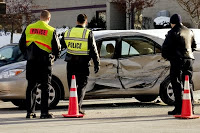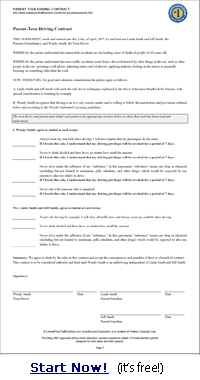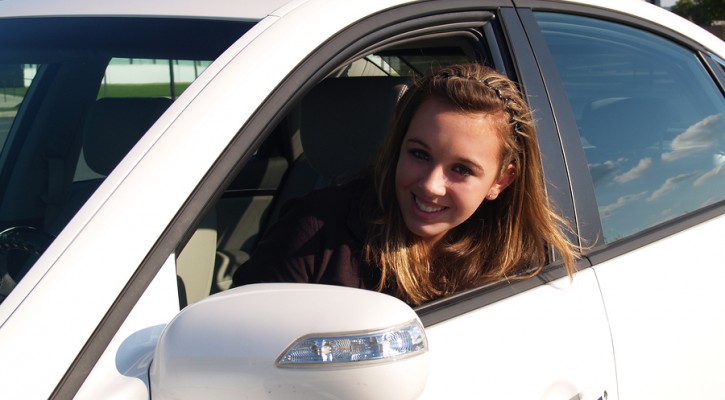Tag Archive: teen driving contract

Teen Driver Safety – When the Crash Isn’t Avoided
June 23, 2010
More often than not, teenagers are taught how to avoid vehicle crashes as opposed to correct procedures if they are ever a crash. Obviously, new drivers are taught defensive driving techniques to ensure their safety on the roadways and to minimize their risks. However, odds are that most teenagers will be involved in at least a minor crash.
The period of time between Memorial Day Weekend and Labor Day is when the most teenagers are involved in vehicular crashes. Below, you will find a basic checklist of things you should go over with your teenager to provide a better understanding of what to do after as well as the insurance aftermath from the crash.
- Discuss insurance basics: If you haven’t already explained to your teenager how insurance rates and premiums work, this is probably a good place to start. Explain why it costs much more to insure an experienced driver and explain the savings associated with a good driving record.
- Consider a contract: A teen driving contract would outline what is expected of the teenager (i.e. safe driving practices, curfews, etc). It would also outline who would cover the rise in insurance costs following a crash and any other consequences your teenager would face as a result of failing to live up the expectations you outlined.
- Insurance and Registration should be in the glove box: Make sure your teenager knows to have the insurance card and registration in a place that is easily accessible and won’t get lost. The glove box is the ideal place.
- Some additional things to consider keeping on hand: A small first-aid kit, self-lighting emergency flares, a disposable camera, a small notebook and a pen to take down another driver’s contact information, and lastly, names/numbers for rescue personnel to contact.
- Document the Crash: Photograph the incident, even if there is minimal damage. If you don’t have a disposable camera in your car the camera on your phone will suffice. If there were any witnesses make sure to get their names and numbers. Witnesses can help you sort out details later.
- File a police report: it is best to file a police report and have it recorded. This is the choice of both drivers to determine even if it was just a fender bender.
- Don’t place blame: Getting involved in a game of finger pointing with another driver is never a good idea. Instruct your teenager to wait in the vehicle until the police arrive if the other driver is trying to confrontational. No good can come from getting in a fight with the other driver.
Even if you think you were at fault, you may not be. That’s why insurance agents recommend that you not accept fault or blame at the scene. It is best to let the police officer sort it out.

How to Use a Teen Driving Contract
April 27, 2009
Teaching your teen to drive safely is one of your most important responsibilities as a parent, and training shouldn’t end when your teen gets a driver’s license.
The early years of driving are a dangerous time for teens. Almost 40% of all deaths for 16- to 19-year-olds occur in motor vehicle crashes; drivers in this age group are four times more likely to be involved in a crash than older drivers.
Setting and enforcing limits on your teen’s driving privileges will help keep your teen safe while reinforcing that driving is a serious matter. Be sure to set limits that comply with your state’s Graduated Driver’s Licensing laws. A Parent-Teen Driving Contract can help you ensure that your teen knows the rules in your household for getting and maintaining driving privileges and the penalties for breaking those rules.
Completing a Parent-Teen Driving Contract will be most effective if the concept and expectation are presented in advance (preferably at age 14). Make sure your teen understands that she or he will not be allowed to drive until an agreement is reached and both parties have signed the contract and initialed each term presented in it. Start a dialogue early about what the terms might include. Set aside at least thirty minutes to review the contract together before you and your teen sign it. Post the contract in a conspicuous place in your home so you and your teen can review it frequently.
How to Use the Teen Driving Experience Log Book
April 23, 2009
One of the Graduated Driver Licensing requirements for a Florida Operator’s License is that the holder of the Learner’s License must have a parent or guardian certify that the driver has had at least 50 hours of experience behind the wheel, ten hours of which must have been at night.
Many parents sign the affidavit without much thought, knowing that they must have accumulated at least 50 hours while teaching their teen to drive. But it’s important to maximize the training quality of these hours. The best way to do this is with a Teen Driving Experience Log Book.
The Driving Experience log helps both the parent and the teen driver ensure that the teen is trained on a wide range of driving skills in a variety of conditions. Here are the components of the log and how to use them:
- Date: Try to space driving lessons two to three days apart. This gives the teen driver enough -time to process the lesson without causing learning fatigue. Try not to let too much time go by between lessons (for example, letting your teen practice driving only on weekends).
- Vehicle: Try to conduct driving lessons in at least two different vehicles, even if your teen will only be using one of the family cars after being licensed. Teen drivers need to understand the differences between accelerating, steering, and braking different vehicles.
Teach your teen to spend a few minutes getting familiar with the location of the gearshift, headlights, defroster, windshield wipers, and gauges when you conduct training in a new vehicle.
- Route: Resist the temptation to allow your teen to practice driving only on familiar routes close to home (for example, to and from the nearest grocery store). While it is important to conduct training in these areas, your teen will likely be driving farther from home soon after being licensed. Expand routes to include challenging roads, such as expressways, as your teen gains experience and skill.
- Practiced: Just as with routes, new drivers should practice a variety of maneuvers. For example, teens should practice parallel parking on downtown streets as well as straight-in parking in shopping center parking lots. They need to learn how to make three-point turns, how to drive in a roundabout, and how to pull safely off the road if the vehicle overheats. Parents who are having trouble creating diverse lesson plans should consult a resource such as the National Safety Commission’s Driver Education Handbook for Parents.
- Weather: Parents may be hesitant to ride with an inexperienced driver on slippery roads, but new drivers will eventually have to contend with driving in inclement weather conditions. They should get this experience while a parent is still present to provide guidance. Most teens are not capable of comprehending the risks of reduced visibility and hydroplaning on their own.
- Remarks: This is a good place to make note of routes and maneuvers with which the teen driver needs additional practice. Staggering lessons so the teen is not practicing the same complicated concepts in consecutive sessions will reduce frustration for both parties.
- Prep Time: Teach your teen driver to conduct a pre-trip inspection of the vehicle. Record this time and lecture time (keep lectures short to compensate for teens’ short attention spans) here.
- Actual Driving Time: End each training session when you sense that you and/or your teen are approaching fatigue, but try to end each lesson on a positive note. If your teen struggles during a lesson, spend the final few minutes practicing a technique she or he already does well.
- Day Driving Time; Night Driving Time: The 50 hours of driving experience including ten hours at night required by the GDL law is a minimum. You are the best judge of how much training your teen needs to be a safe driver.
- Debrief Time: Calmly discuss your teen’s progress. Be sure to allow your teen to give feedback. Reassure your teen that you will continue practicing difficult maneuvers and offer praise for her or his successes.
Teaching their teen to drive is a stressful, emotional experience for many parents, but making training time count is one of the most important things you will ever do for your child.

Buying the Right Car for Your Teen Driver
December 1, 2008
Most parents instinctively know that buying a sports car for their teen drivers would probably be a big mistake. A high-horsepower, easily maneuverable car could be a deadly temptation for a teen, especially combined with the teen’s feeling of invincibility and risk-taking behavior. But if your child is pressuring you for a sporty convertible, here’s some ammunition for saying no.
The first years of driving are very risky, no matter what your teen is driving. Teen drivers have the highest death rates in car crashes of any age group. Motor vehicle crashes are the number one cause of death among Americans aged 15-20.
And some cars are simply more deadly than others. According to the Insurance Institute for Highway Safety, small sports cars such as the Ford Mustang, the Chevrolet Corvette, and the Pontiac Sunfire have the highest death rates in crashes. “Vehicle choice does matter,” says J. Peter Kissinger, president and CEO of the AAA Foundation for Traffic Safety. “Use it as another means to have a conversation with your teen.”
For more support, go online with your teen and check out insurance rates for their vehicle of choice. Explain that adding the teen to your policy will raise your rates no matter what she or he is driving. “Having a young driver added to your insurance will raise the rate 50 to 100 percent,” says Jeanne Salvatore, vice president of consumer affairs for the Insurance Information Institute. But the rates are much higher for vehicles considered high-risk.
Lastly, and perhaps most important, you are still the parent. Getting a driver’s license is an exciting rite of passage for your teen, but this new level of independence doesn’t end your primary job as a parent – to make the safest possible choices for your child.
Many parents, swinging to the other end of the pendulum, think an ancient clunker shaped like a tank would be safest for their teens. But experts demur, for two main reasons. First, the poor acceleration power of an older vehicle both makes it more difficult for teens to accelerate in some driving situations, such as lane changes and highway merges, and tempts them to simply drive faster to make up the difference in accelerating power. Second, older vehicles don’t have the benefit of modern safety features, such as airbags and electronic stability control.
So, with these two vehicle types out of the question, how do you select a safe car for your child?
First, consider size. A mid- or larger-size car could mean the difference between life and death in a crash. Though that’s true for drivers and passengers of all ages, it’s especially true for teens because of the high likelihood of driver error, which often leads to a crash.
Former National Highway Traffic Safety Administration chief Jeffrey Runge, a former emergency room physician, recommends vehicles weighing at least 3,300 pounds for teen drivers. This is a good guideline for parents who are unsure of which vehicle class to shop in for their teen’s car.
Here again, some parents go to the extreme and choose an SUV for their teen drivers. But most safety experts think this a mistake. SUVs have a high center of gravity and thus are more likely to roll over than other vehicles. Drivers aged 16 to 20 are more than twice as likely to be involved in a rollover in an SUV than older drivers. Second, SUVs can be challenging to handle in an emergency, making them a better choice for those with more driving experience than teens. And SUVs carry more passengers, which make the vehicle more unstable and can be highly distracting for a teen driver.
A second important consideration in the choice of a car for your teen is crash protection. Although a vehicle with front driver and passenger airbags should be relatively easy to find, consider side airbags that protect the head and chest. You’ll have to do some research, because not all car manufacturers approach this the same way. “The trend is now more curtain airbags for the head and more door-mounted for the chest,” says Mark Krawczyk, consumer information director for the National Highway Traffic Safety Administration.
Electronic stability control helps drivers maintain control of their vehicles during extreme steering maneuvers. Since teens are prone to overcorrecting in an emergency, it may be well worth it. The feature “cuts single vehicle crashes by more than half in our studies,” says Susan Ferguson, senior vice president of research for the Insurance Institute for Highway Safety.
Anti-lock brakes (ABS) also allow a driver to maintain control of the steering during emergency braking situations. Be sure to teach your teen to use anti-lock brakes properly in an emergency – hit the brakes hard and don’t let up. The pulsing vibration you feel means the ABS are working; some drivers instinctively let up on the brake when they feel it, so it’s important to practice not letting up on the brake so your teen will do the right thing in an emergency situation.
If your budget allows, check out the more advanced crash-avoidance technologies found on newer modes, such as emergency brake assist, lane departure warnings, and blind spot warnings.
And don’t forget the basics. All vehicles come with safety belts – make sure your teen wears them on every trip. Don’t forget to check the tires, headlight and taillights on a regular basis to make sure they’re in good working order.
Lastly, when buying a car for your teen, realize that you are entering a new era of driver training. Your teen will be excited and very probably overconfident in her or his abilities. Be sure to train them in the vehicle you choose. Require that your young driver demonstrate responsible behavior and meet experience requirements in diverse road conditions before heading out on the road alone. Check up on them frequently. Sign a teen driving contract to make sure your teen explicitly understands your requirements.

Nearly Half of Teens Admit to Texting While Driving
December 1, 2008
While recent studies indicate that teens agree that texting while driving is dangerously distracting, a significant number still continue to do so.
In a 2007 study by SADD (Students Against Destructive Decisions) and Liberty Mutual Insurance Group, 37% of teens rated text messaging as “extremely” or “very” distracting. A statewide study by AAA Colorado showed teens feel even more strongly about the risk:
- 97% think text messaging while driving is dangerous.
- 91% think there should be legal limits on cell phone use, including text messaging, while driving (these laws do exist in many states; some target only teens, while others extend to all drivers).
- 74% admitted not knowing the law regarding cell phone use and driving in Colorado (meaning education and enforcement should be a priority).
- 73% said strict penalties, such as losing their licenses, would make them less likely to text while driving.
But in a separate AAA study, 46% of teens admitted to texting while driving. And in the Colorado study, the numbers were even higher – 51% confessed to it, and 38% admitted taking their eyes off the road while text messaging.
Many states have or are considering laws prohibiting teens from texting while driving. California’s law went into effect on July 1. California Highway Patrol spokesman Tom Marshall said that officers have to spot another offense before stopping teen drivers who are text-messaging because the law classifies texting and driving by teens as a secondary offense.
After the Colorado survey, state troopers planned to increase education efforts and continue cracking down on drivers who break the existing law, which makes it illegal for teens with an instruction permit to use a cell phone, whether talking or texting, while driving.
Whether the law supports them or not, parents need to take a stand with their teens against text messaging. Teens know the danger exists, but the feeling of invincibility and the desire to maintain close contact with friends that are typical of this age allows them to ignore it. Many teens won’t comply with a directive against text messaging while driving unless they know there are consequences. In the SADD/Liberty Mutual study, 52% of teens who say their parents are unlikely to follow through on punishment if they drive and text will continue to do so, compared to only 36% of teens who believe their parents would penalize them.
To educate your teen about the risk, ask your teen to tell you how texting and other distractions would affect your driving as you drive with the teen as a passenger. Would you have missed that traffic light? Rear-ended a stopped school bus? Veered over the center line? Share the following tips (be sure to follow them yourself to set a good example):
- Turn off your cell phone while driving. Let voicemail capture your voice and text messages.
- Pull off the road safely and stop if you need to send a text.
- Recognize that wanting to be available at all times can be a habit that will negatively affect your driving at best and could cause a terrible crash at worse. Let friends and family know that you won’t be responding to text messages while driving.
- If you just can’t resist texting and driving, put your phone somewhere you can’t reach it, like the trunk of your car.
Parents often want their children to be available by phone at all times, but you are putting your child at great risk by expecting an instant response to your “Wher R U?” text. Establish regular check-in times when your teen won’t be driving, and resist the urge to text at other times.
Review your teen’s cell phone bill with them regularly to see if they are texting at times when they are likely to be driving. Specify the penalty for violating the rule ahead of time, and be sure to apply the punishment consistently if your teen breaks the rule. Teens should sign a Parent Teen Driving contract in which they agree to focus all of their attention on driving during each and every trip.
Whether your state has a graduated driver’s licensing law or not, use a Driving Log to keep track of the hours you spend on your teen’s driver training. Make a note in the log to review common driver distractions, including texting, during each lesson.
If you’re wondering whether you could simply disable the cell phone while your teen is driving, thereby reducing the need for your policing efforts, wonder no more – cell phone jammers are illegal. Though the law, enacted in 1934, was mainly written to protect radio and television broadcasters from the pirating of their airwaves, the penalties for having the technology are severe – a fine up to $11,000 and a jail term of up to one year.
